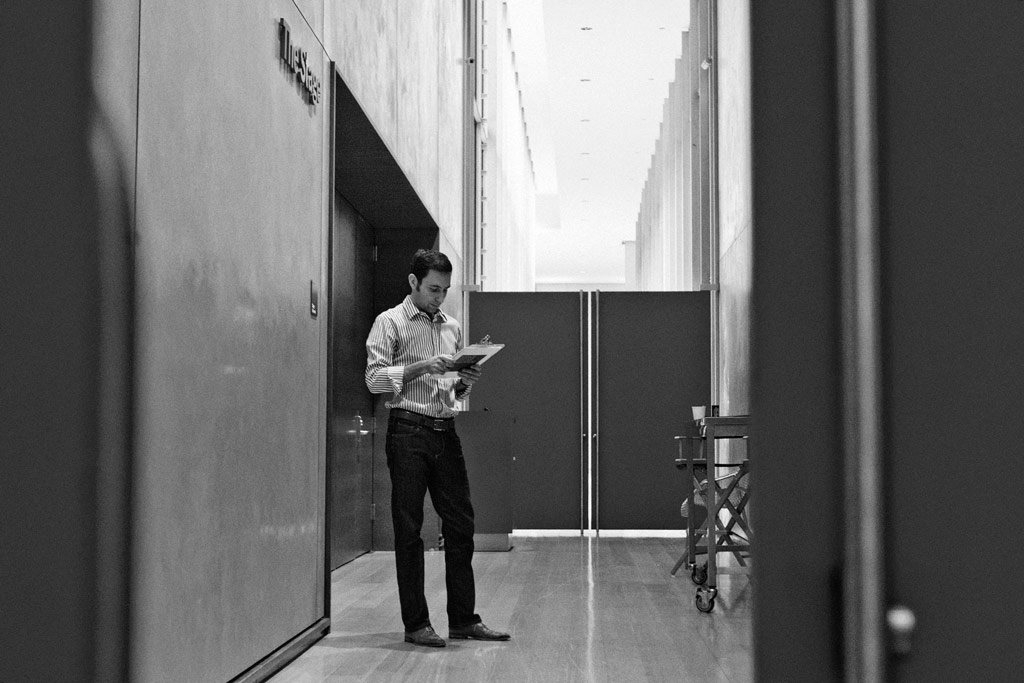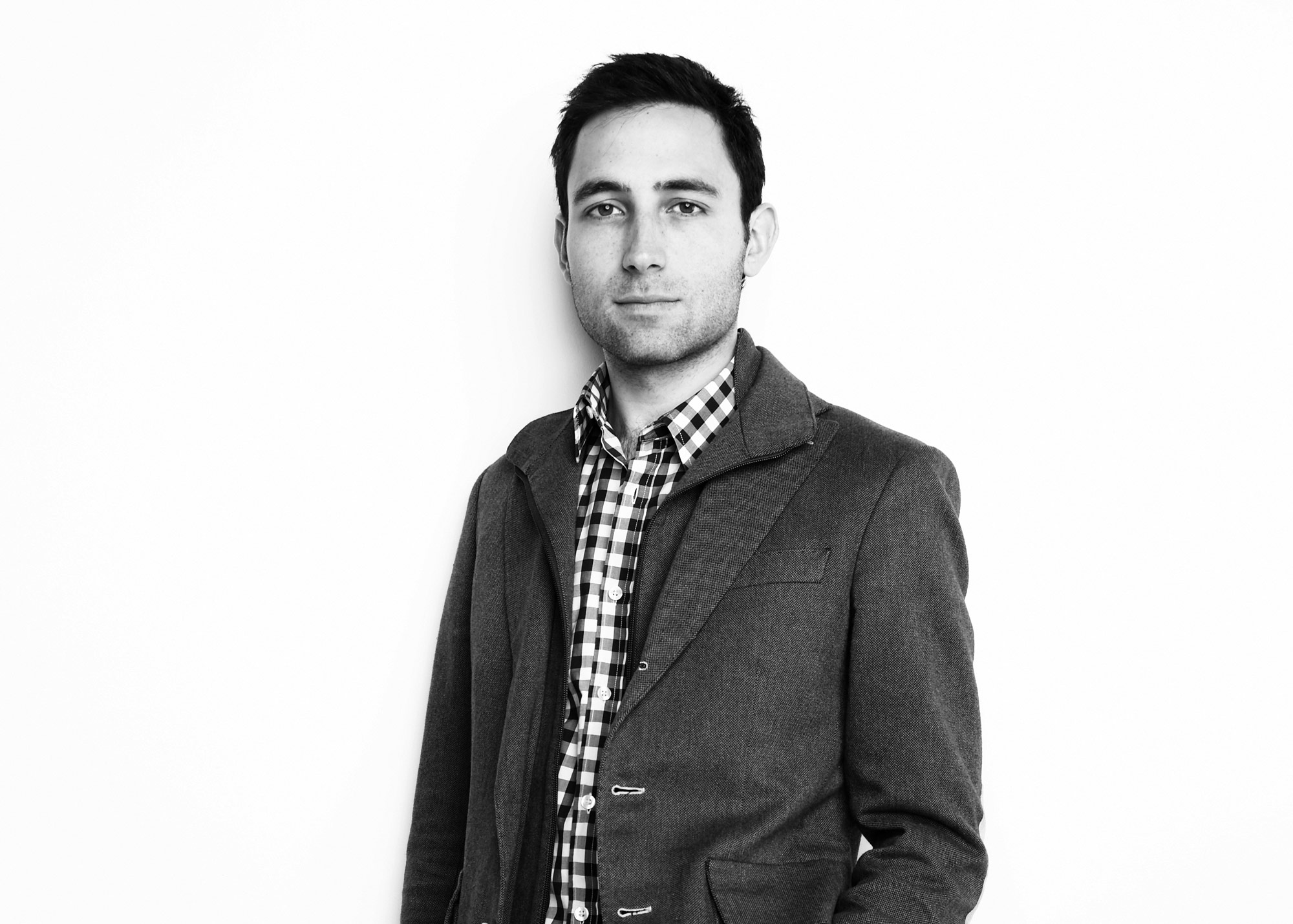
- Interview by Ryan & Tina Essmaker July 30, 2013
- Photo by Júlia Soler
Scott Belsky
- entrepreneur
- publisher
- writer
Scott Belsky is Adobe’s Vice President of Products/Community and Head of Behance, which he cofounded in 2006 and served as CEO of until Adobe acquired Behance in 2012. Prior to Behance, Scott helped grow the Pine Street Leadership Development Initiative at Goldman, Sachs & Co. He attended Cornell University as an undergraduate and received his MBA from Harvard Business School. Scott and his wife live in New York City.
Interview
Describe your path to what you’re doing now.
Well, I was always trying to solve problems with design, even before I knew what that meant. Prior to high school, I was using Photoshop and Illustrator for projects. In fact, I used to earn extra credit in science by redoing the diagrams for the overhead projector. I’d take concepts from the textbook, make a graphic, and get extra credit for my work. I didn’t realize it at the time, but I was obsessed with using design to organize information.
In college, my senior thesis project was redesigning the résumé for the creative person. Recruiters were coming to campus, saying they wanted to hire people for their creative potential—and not just designers, but everyone. They asked people to submit a one-page Microsoft Word document that encompassed their potential, and I thought that was ridiculous. I started thinking about how design could make a person’s résumé more dynamic and allow strengths to come to the surface.
After college, I started working in Corporate America. I was at a big investment bank doing leadership development and succession planning within the business. I was the only person in the company who had Illustrator and I used it to help communicate information that Excel didn’t do justice.
Then, in 2005, I met my Behance cofounder, Matias. We were introduced by a mutual friend as two people with a shared interest in designing for the creative world. At first, I hired Matias as a freelancer and he awakened in me a realization of how important design was in everything we were doing. His background was in graphic design and he had formal training, which I didn’t have. The first week we worked together, he spent time teaching me about kerning and typography, which was key in choosing our Behance identity because it was important to spreading the message of what we are about. We made Behance a full-time job in early 2006 and brought on Dave, Chris, and other brilliant minds to help make Behance happen. Matias and I—and all of our leadership team across the business—are still working together after all these years.
A few interesting things to note along the way. One, we bootstrapped our business for five or six years. When you do that, you hire people who are there because of what you’re doing—not because of the options or investors. The people we brought in were genuinely interested in solving the problem: the creative world is one of the most disorganized communities on the planet. The creative community makes our lives interesting; they create stuff that compels us to understand the world, make sense of events, and take action. Yet they often say that their careers are at the mercy of circumstantial opportunities and networks of people they just happen to know, rather than proactively pushing their careers.
The second thing we realized is that the creative world has no transparency. It’s very hard to know who does what. At the end of the day, an agency or brand takes credit for something when, in truth, that’s not the case at all—there are all these people who actually did the work. That’s even true at the portfolio level; we can show our portfolios, but in a sense, they are a lie because the work isn’t done solely by us. Other people were involved. The attribution in creative work has never gotten the spotlight it deserves. The Internet complicates attribution because work circulates and becomes disconnected from those who created it.
However, if you foster attribution, there is so much opportunity. Organizing portfolios by who did what helps people showcase work and helps others discover it much easier. Transparency is an essential step toward meritocracy—people getting an opportunity because they deserve it is really about them getting the credit they deserve. If I know who did something amazing, then I can hire them to do something amazing for me; and by the way, if I know how great they are, I’m going to pay them more. From the beginning, the vision of Behance has been to empower creative careers, organize the creative world, and provide transparency where there is none. The journey has been a ton of fun and we still feel like we’re in the early innings.
So, what did you do prior to Behance? You mentioned that you didn’t study design in school?
As an undergrad, I studied business and took a lot of classes from a major called DEA, which is Design and Environmental Analysis. I realized that I had a real affinity towards design, although I never had any formal training in it. I always thought in terms of information design, even though I didn’t know what that meant.
Then I decided to get a job in business. I was intimidated by the business world and wanted to figure it out. I worked in finance for a year and half; then I took a job at the same company, but worked more in organizational development. That’s when I realized that I love thinking about team leadership and how a company is structured, but I also felt like the world that needed the most help was the creative world, which I always had an affinity for. The thought of bringing business best practices and insights in leadership development and organizational structure to the creative world, where everyone considers their disorganization to be a badge of honor.
I also remember realizing how many companies, books, and conferences existed for creativity; it was all about inspiration and ideas. The funny thing is that the last thing Creatives need are “more creativity and ideas.”
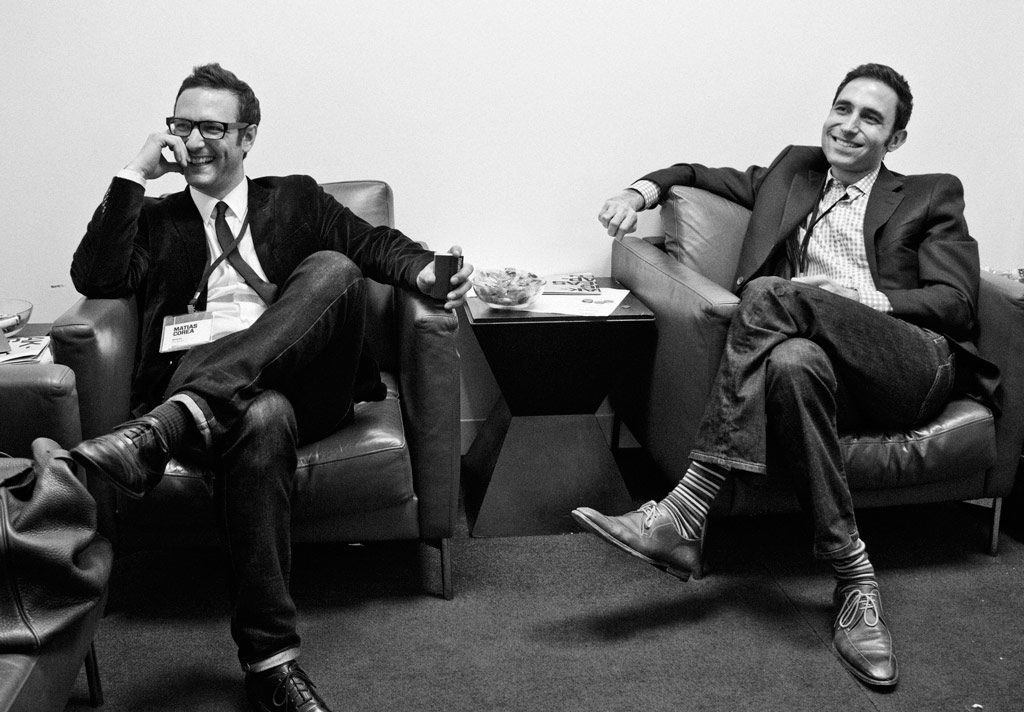
“From the beginning, the vision of Behance has been to empower creative careers, organize the creative world, and provide transparency where there is none.”
Tina: That is so true!
Right? I’ve never met a really creative person who told me, “I’m looking for more ideas.” They’re just trying to make ideas happen—that is what we struggle with. The thought was, let’s focus on helping creatives actually create; let’s help them get organized and get their shit together. I didn’t even know if there was a business there. Behance started out as a blog about creatives who manage their businesses, build teams, lead ideas into fruition, and serve as stewards of the creative process, rather than going into it without a thought.
The word Behance came from the word enhance, which means to make better. Be meaning people need to do it for themselves and take the responsibility of enhancing their potential. That was the concept.
So, the blog started and Matias and I built our first product together: our notebooks. That was the physical manifestation of our mission to organize the creative world. It was at that moment when we had a blog and launched the paper product that we decided we wanted to be a mission-centric, medium-agnostic business. Mission-centric meaning that everything we would ever do would be about empowering careers and organizing the creative world, but that we would pursue it through any medium possible—whether the medium of a blog, paper product, conference, or even an online network. We bootstrapped the business with the paper product and started thinking about the network, which materialized into Behance’s online community.
Was creativity part of your childhood?
It was. I had parents who treated me independently, so I was oftentimes on my own. I have a sister, who is three years younger than me, and she was born with special needs—the doctors weren’t certain if she was even going to be able to talk. I think my parents were so focused on her, plus I always had this mentality of, “I’m okay, don’t worry about me!” As a child, I spent weekends in the basement making stuff and creating. For example, I’d take all of my LEGOs out of their boxes and mix them up to make my own things; I never followed the directions on the LEGO box, because why would I want to do that? It’s so boring to build something step by prescribed step.
I think those ingredients from my childhood—having to entertain myself and being given independence—have led to who I am today and, ultimately, made me into a product person. If you ask anyone at Behance where I spend my energy and time, it’s on products. One of the greatest privileges of my life is working with and learning from a design team who also shares in the excitement of building products to help organize creatives.
Tina: Going back to what you said about your sister, I can relate. I have a twin brother who has special needs. My parents spent a lot of time helping him and I was always off on my own, playing and imagining. Even as a child, I felt very grown up.
When you grow up with a sibling who is going through something, whether they have special needs or an illness, you just don’t want to be a concern.
Tina: Exactly. You don’t want to be a burden and you also want to help out as much as you can.
It fosters a lot of independence and I think that kind of independence is a great ingredient for entrepreneurship. When you’re working at a large company, you have bosses—or parents—who tell you what to do; with entrepreneurship, you don’t have that. When you’re on your own building something, you need to have that streak of independence and self-reliance in order to feel comfortable.
Tina: Definitely. It’s so interesting how our childhoods shape our personalities and even what we end up doing in life.
Totally. I think about it all the time.
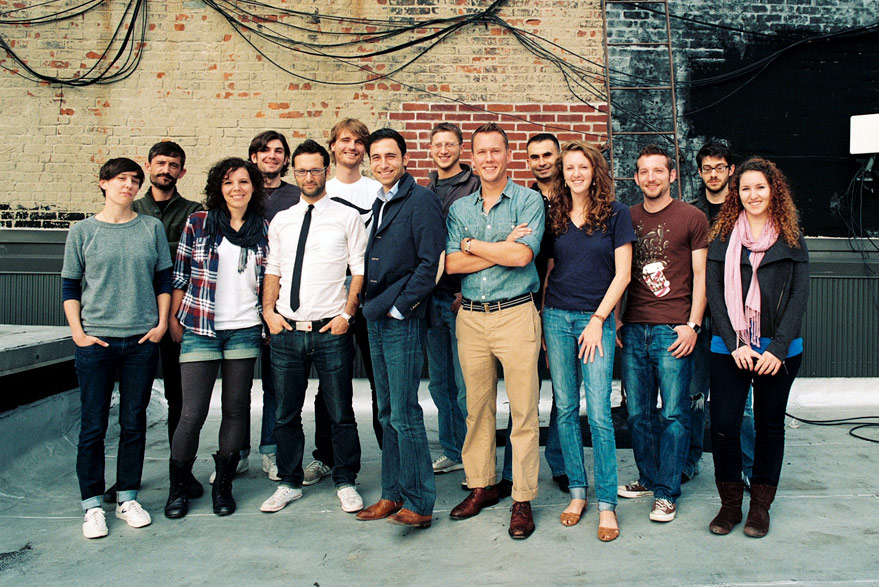
“All of our executive team at Behance started out being unqualified, including me. We’ve developed each other into the roles we now play by sharing difficult feedback and going through challenging times together.”
Have you had an “aha” moments when you knew what you wanted to do?
Well, I think I’ve had two types of “aha” moments: the ones I’ve had about my team and the ones I’ve had surrounding working with products. On the team side of things, seeing people develop really does it for me. I like seeing individuals grow into the roles they end up playing. All of our executive team at Behance started out being unqualified, including me. We’ve developed each other into the roles we now play by sharing difficult feedback and going through challenging times together. They are the kind of people I want to work with, and it’s so rewarding to have moments of success with them.
The other part of that is about what we’re creating. I talk about team as a separate entity because it’s almost like we could work on anything together, however, that’s not entirely true. If we were creating something that was optimized to sell ads, we would not feel so great about the outcome. For us, success looks like people saying they got discovered or got a job. Ultimately, Behance works if talent is matched with opportunity and creatives get the credit they deserve—and if creative careers become better.
When people talk about their business’ success, they often fail to talk about the years when they were in anonymity and there was no revenue and no external rewards. A quick side note: as human beings, we’re all addicted to short-term rewards. One of my favorite quotes, shared by Fred Wilson at the first 99U Conference, suggests that, “The two greatest addictions in life are heroin and a weekly salary.” If you unplug from either, you’re going to go through severe withdrawals and perhaps not even survive. And that’s true.
When you’re starting a new venture, you’re unplugging from the reward system that we’ve all grown up with since day one, when we studied for quizzes and wanted to please our teachers and parents. Suddenly, the weekly salary and the bonus check are gone for years. I actually don’t think we can defy the importance of short-term rewards. I don’t buy it when people say they’re only interested in long-term rewards, or some goal five years from now. That’s great, but that will not keep you working from day to day—it just won’t work. Instead, you need to short-circuit your short-term reward system. The way we did that at Behance was through the testimonials people were giving about the site.
I remember another one of those moments in our business. We’d always search for “Behance” on Google and it would suggest searching for “enhance” instead. (laughing) We looked forward to the day when we weren’t a mistake. One day, we searched and there were five results for Behance and no prompt for us to retype the search. That was a short-term reward that we had created for ourselves, which had no financial impact. Those are the kinds of things you need to keep going.
Tina: We definitely agree. Being able to publish an interview every week and get feedback from readers is very rewarding, especially when people say it helped them make a big decision about their career or life. That’s really encouraging to us. It’s not a financial reward, but it’s very meaningful.
You know what you’ll find is that a labor of love always pays off—maybe not directly or even logically speaking, because you can love something and it can fail—but somehow, it leads you to something else. It almost always pays off in unexpected ways. You just have to keep churning it out.
Agreed. So, you mentioned being an entrepreneur and not having a boss to guide you, but have you had any mentors along the way?
Yeah, I’ve had a number of mentors. It’s interesting because I don’t mind having a board or a boss—ultimately, we all answer to other people, including our community of users. But yes, I have had specific mentors who have had a huge impact on my life. For example, Seth Godin is someone who really makes life decisions according to his priorities and values. I remember asking him once why he doesn’t use @sethgodin on Twitter—he uses @ThisIsSethsBlog. His response was, “I don’t want to feel obligated to answer every tweet.” It was an interesting point, and it made me think about the balance between constantly reacting to stuff and focusing on the work that matters most to me. That’s just one example of advice he’s given me that makes me question my ways. Seth seems very focused on his intellectual pursuits and writing, and he’s written over 20 best-selling books, so there’s some wisdom there. I’ve always admired him for his principles and his boldness to build a life that’s grounded in those principles.
John Maeda is also someone I’ve always looked up to. He looks at things with an angle that I aspire to see. Being able to be around him and soak some of that up has really meant a lot to me.
There are a lot of people I’ve met over the years whose authenticity and perspective on things has resonated with me and influenced the way I think.
“I think those ingredients from my childhood—having to entertain myself and being given independence—have led to who I am today and, ultimately, made me into a product person. If you ask anyone at Behance where I spend my energy and time, it’s on products.”
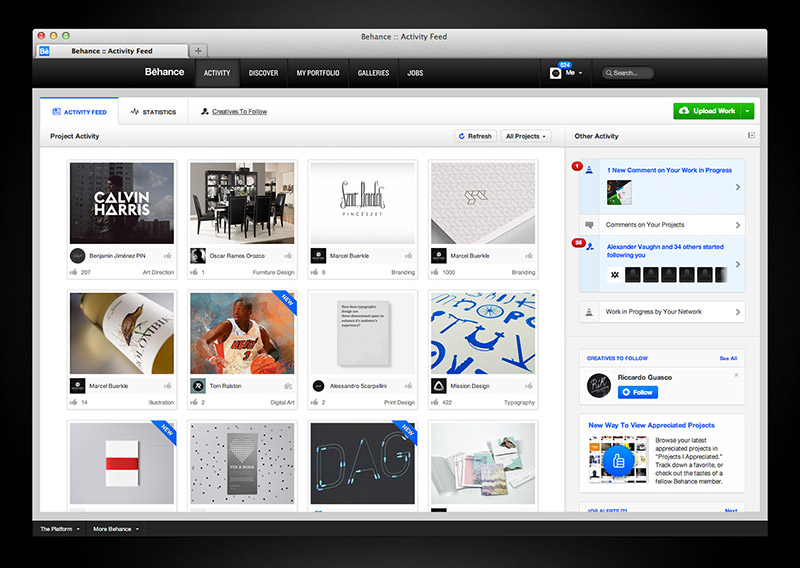

Has there been a point when you’ve decided to take a big risk to move forward?
There were a number of big risks aside from starting Behance. One of them was raising money after being a bootstrapped business for almost six years. We knew that if we took on capital from a third party, then we would be obligated to build a business with exit value, rather than a lifestyle business for ourselves. The reason we ultimately decided to take money was because we wanted to do the greatest work of our lives. To do that, we needed to hire some people who we just couldn’t afford. The leader’s job is to be the wind at the backs of the team; if I’m telling my team they can’t have the resources they need, then why would they stay? I felt like I was strangling the potential of our business if I didn’t make sure we had the dream team to be able to build what we wanted to build. I was willing to take the risk of losing some control and independence that comes with investment. That was one risk.
The other more recent risk was joining Adobe. It was a very difficult decision, and one that would change control significantly. What had to happen for me—and the Behance team—was understanding the kind of company Adobe wanted to be. Most companies know exactly who they are and they are who they are; when they acquire another company, they just want them to fill in some little hole. However, Adobe knew they wanted to go from a software business to a services business, and when they took on Jeff Veen and the Typekit team, that was a strong indicator that they were willing to make that transition. Also, the fact that Jeff is still there and leading is very reassuring.
Then we asked ourselves a few important questions: money and acquisition accolades aside, what’s the best way to organize the creative world and provide the transparency we’ve always envisioned? What’s the best way to get the resources we need to do the greatest work of our lives? If we were integrated into every creative workflow in real-time around the world, then that would be an incredible opportunity. With the way Adobe was shifting, we felt sure that they were going to be a services business based on community, social sharing, and collaboration. We felt like not only would Behance be an incredible part of that puzzle, but it would also potentially put us in a leadership role in the future of Adobe, which was so exciting to us.
Also, everyone was super psyched about the value we had built as a business. Now, we have the ability to have a team that is financially compensated for their work and can focus on the work itself without worrying about raising another round or needing to get paid more because salaries aren’t enough. Joining Adobe has relieved some of the anxieties around that part of the business so we’re able to focus more on doing what we set out to do. I have to say that, seven months in, it’s going really well. I think we’ve had to prove ourselves to our new colleagues at Adobe in terms of what we’re focusing on, how crystallized our vision is, and how motivated we are. We’ve done a good job of that, but we’re still in the early stages of what we’re all going to do together.
Are your family and friends supportive of what you do?
Yeah, they are. They’ve been very supportive all along, although they haven’t always understood what I’m doing. (laughing) I like to say that to create something extraordinary, you have to learn to gain confidence from doubt. When you go to family and friends, describe what you’re doing, and they doubt or don’t understand it, then that is a sign that you might be onto something remarkable. If they totally get it, then you’re in trouble, because it’s too common and everyone is familiar with it. That’s easy to say, but hard to manage when you’re hearing things from family like, “Is this going to work?” or, “Is that a real job?” Thankfully, my family has always been supportive and has appreciated my creativity.
My wife, who is a psychologist, has also been really supportive. She’s been really helpful and I’m probably her biggest patient. (all laughing) It takes a lot of people around you to make you feel like you’re allowed to fail and will still be loved.
Tina: As a side note, did you grow up around here?
I grew up outside of Boston. New England’s culture is a little different than New York, but I feel like this is my city now. I really love the energy. New York feels like an epicenter of the creative world—there’s fashion, the design community, a tremendous amount of architecture, the advertising industry, and so much more. This is probably the right place for us.
Tina: How long have you been here?
Since 2002.
Ryan: I think that everything Behance does answers this question, but do you feel a responsibility to contribute to something bigger than yourself?
I do. Everything that is truly only for yourself empties very quickly. It’s almost like having the most amazing meal of your life, but eating it alone—it doesn’t mean anything unless you can share it with someone. I think that can also be said for the mission of a business. As successful as any business might be, it has to be for something that you believe is greater than yourself. That also attracts the right people to work with you; you want to work with people who want to do something greater than themselves. When you’re working with people who are selfish and doing things only for themselves, it hurts the product.
A brand’s social component not only appeals to customers, but it also attracts the type of team that thinks beyond themselves. I don’t think the reason Warby Parker is so successful is because of the glasses they’re giving away; I don’t think the reason TOMS is so successful is because of the shoes they’re giving away. I actually think that because of those programs, they attract the type of people who can build product with a sense of empathy, and make the right decisions. If they were selling crappy glasses or shoes, then people wouldn’t by them, even with the social component.
At Behance, we’re trying to empower creative careers around the world. Creative people know no bounds and some of the greatest creative work is coming out of Central and Eastern Europe, Russia, and a lot of developing countries. For example, there are millions of people in India who don’t have a computer, but they have mobile devices. They are able to learn how to photo retouch or do things that could, in essence, allow them to be connected to a global creative economy and make a living for themselves. It’s a very empowering notion to help people showcase their work, no matter where they are, in hopes of being found and getting opportunities. Those are the things our team talks about when we get together for dinner: what could this mean beyond us? That is what drives us.
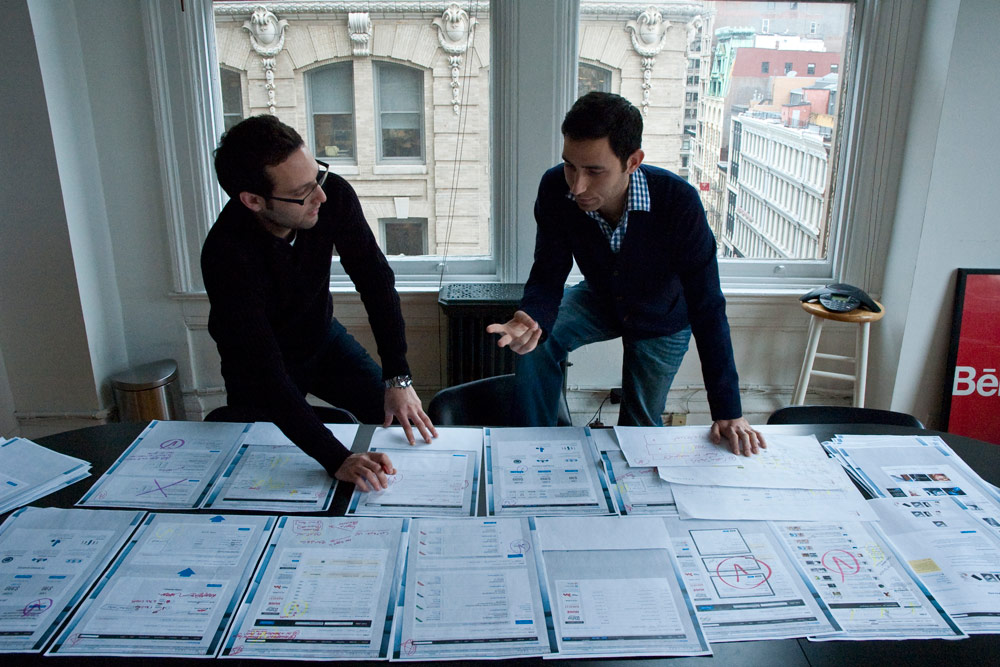
“Everything that is truly only for yourself empties very quickly. It’s almost like having the most amazing meal of your life, but eating it alone—it doesn’t mean anything unless you can share it with someone.”
This is a big question. Are you creatively satisfied?
Never. I mean, the evidence of that is that when I go to bed most nights, I have to reach over and grab my iPad or notebook to write ideas down. When I’m driving, I have to pull over because I don’t want to carry an idea in my head; I’m scared I’m going to lose it, so I have to capture it. It drives the people around me crazy and I also get frustrated—can’t I just go to bed? If I was creatively satisfied, then I would just let that stuff go. But I am insatiably interested in doing something with those ideas and it’s a burden I hope I never lose. I think we are all like that to some extent with the things we’re interested in. It saddens me when people are doing work that they’re not genuinely interested in. They’re missing out on that insatiable interest that keeps driving us to capture ideas, implement them, and complete that void we have for creating something from scratch.
Tina: We know you have plenty of ideas, but in the next 5 to 10 years, is there anything you’re interested in exploring or doing?
I’ve actually never been part of any product team to make a creative application. Behance helps you showcase your creations and become a better creative professional, but I’ve never done the kind of stuff Adobe does—building the creative applications themselves. I hope there is some opportunity to work with the future of creative applications.
There’s a lot more writing I want to do as well. I love writing as a means of engaging with many people I don’t know. I also like reading what other people have written and being a part of that thought exchange. It would be fun to do more of that—but I still feel like we’re in the early innings of ideas at Behance!
Tina: So, more of what you’re already doing with some new things mixed in.
Yeah, I want to challenge myself and keep learning. From a management standpoint, managing a team of 50 people is a lot different than managing a team of 15 or 20. It’s an art to make sure that everyone is communicating, that people are in sync, that there is prioritization, and that, at the end of the day, you can push something forward in a meaningful way. As a company gets bigger, those things become harder to do. Fortunately, we brought on Will Allen to fill our Behance team’s COO role almost two years ago, and he and I have worked closely in managing the growth and keeping the secret sauce alive. I’m excited to figure out these challenges and I think that’s part of the learning curve I’m now in.
Tina: Is your entire team in New York or do some people work remotely?
The whole team is based here.
Ryan: Have you ever worked with anyone remotely?
Well, now I work with a ton of people remotely through my new role in Adobe. I think it’s all about communication and having that gut instinct of knowing when you’re not aligned and something needs to be clarified—and then actually clarifying it. Ambiguity kills great ideas, and great leaders kill ambiguity. You definitely have to assert yourself more when you’re not working in the same place.
“…the greatest competitive advantage in business and life is self-awareness…What we should be investing a tremendous amount of time and energy into is our own self-awareness, which means investing in our own psychology in order to understand and develop ourselves…that’s the number one thing you can do to stay ahead of the curve.”
If you could give advice to a young person starting out, what would you say?
One piece of advice is that the opportunity cost of waiting to do what you want to do just goes up. The excuses you tell yourself to wait to try what you have in your mind are wrong. In truth, you will have more responsibility tomorrow than you have today—it’s a fact. You can always find a reason why you should wait, and some are very valid, like having to pay back student loans, but recognize the fact that the opportunity cost goes up, not down. Whenever people talk to me about their ideas, I get frustrated because I want them to do something about it. Take action on things that are in your mind’s eye. That’s one piece of advice.
The other thing is that the greatest competitive advantage in business and life is self-awareness. As a business, as you become more confident in what you’re doing, you can also become less self-aware about the things you’re bad at. As a result, other more aware companies will beat you. And in our own personal lives, when we neglect to see our own faults and weaknesses, people start to resent us; we start to not communicate as well; and things will fall apart. What we should be investing a tremendous amount of time and energy into is our own self-awareness, which means investing in our own psychology in order to understand and develop ourselves. I just know too many ambitious entrepreneurs who would never think of seeing a psychologist or keeping a diary and analyzing what they deal with or asking colleagues for feedback and regularly incorporating that into improving their way of working. To me, that’s the number one thing you can do to stay ahead of the curve.
How does living in New York impact your creativity?
I feel like I get my creativity more from traveling and being in new places rather than from the place I’m familiar with. Familiarity breeds complacency and disinterest. It’s when I push myself to go somewhere I’ve never been or have a new experience that I start to think about things differently. I don’t mind getting lost; I don’t mind waiting for people. When someone is running late, I start to look around and pay more attention to my surroundings. You have to capture the benefits of all the circumstantial stuff: the accidents, the people you happen to run into. That’s what inspires me creatively.
Is it important to you to be part of a creative community of people?
Yeah. It’s also what keeps me humble. When you’re part of a creative community and every day you see stuff that blows your mind, you realize how talented others are. You have to see what others are creating in order to stay humble and keep perspective. Creative community not only inspires you, but also grounds you.
What does a typical day look like for you?
Now, the typical day for me begins with waking up early, around 6:30am, and spending an hour with my 11-month-old daughter. I don’t really see her at night because I get home after she goes to bed. In the morning, no one is awake yet and I can focus on being with her. Swimming is my exercise and I try to do that a few times a week.
My workday is a lot of what I call a reactionary workflow: responding to emails and things like that. I try to include windows of non-stimulation in each day so I can focus on research I’ve found, read articles, or actually process something. So often, we can go to work and the entire day will be spent reacting without any period of time where we’re absorbing or thinking. My favorite time of the week is our concepting meetings. Concepting is where I sit down with the product design team for a few hours and we debate and review everything we’re working on. After work, I’ll often have dinner with another entrepreneur friend or someone I’m advising, and we’ll exchange advice. Or I’ll stick around the office and hang out with the development team as they’re doing a late-night push of a new version of the network or a new feature, because I like to be there to help test and support. That’s my regular schedule, but every day also includes things that aren’t scheduled.
Are there any albums you’re listening to right now?
I love the new Daft Punk album.
Do you have any favorite movies or TV shows?
I just watched The Godfather Trilogy in order and it’s such brilliant cinema. I love the movie Contact, which was based on a book by Carl Sagan. I wish I had more time for TV shows, although I loved Breaking Bad and Game Of Thrones—no surprise there.
This might be a difficult one. Do you have a favorite book?
I just read Sum by David Eagelman, which is a book of short essays about life after death, given to me by 99U’s Editor-in-Chief, Jocelyn Glei. It was all these little vignettes about what happens after you die. They were so creative and wild and fun. I also like biographies and have read of a lot of ones by Walter Isaacson. I also wish I had more time to read.
Do you have a favorite food?
I’m a vegetarian and have been since I was 11 years old. I did get very, very sick from meat when I was 11 and lost my taste for it for a while. Then I got into the mindset and health benefits of being vegetarian and decided not to eat fish or meat anymore. I’ve been a real vegetarian ever since.
What kind of legacy do you hope to leave?
One of the things I really took from my father, who is a doctor, was his work ethic. I watched him work on the weekends, make house calls, or go in for emergencies. He would wake up early in the morning and stay up late at night to work on dictations for patient charts. He takes pride in the work he does in the service of others. I believe that you have to work hard to make something happen. You don’t have to be brilliant or have the best ideas; you just have to work hard. At the same time, he’s always been there for family. Somehow, he achieves that balance. I hope that’s one legacy I leave for the people I know, as well as for my own family.
For the world, I hope that I can be an advocate for creative potential. There are probably more half-written novels in the world than completed ones. The solutions to all of our gravest problems in society are in the minds of creative people out there: the creative chemist who works in a lab somewhere but can’t stay organized, or doesn’t have the impetus to act, may have the cure for cancer. Obviously, all of the greatest artists who we know are the ones who have produced stuff, but that doesn’t mean they’re the ones with the greatest insights. I would like part of my legacy to be helping creative people make stuff by focusing on everything but the creative part of it. If someone were to ask what Behance did, I would love to say, “We helped creative people make their ideas happen.” That would be really cool.
“…a labor of love always pays off—maybe not directly or even logically speaking, because you can love something and it can fail—but somehow, it leads you to something else. It almost always pays off in unexpected ways.”
